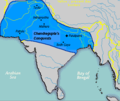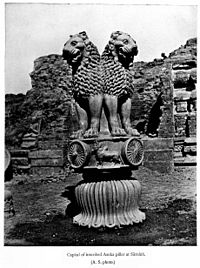
TheAurangzebAtrocities VII
About the time the general order for destruction of Hindu temples was issued (9th April 1669), the highly venerated temple of Somanath built on the sea-shore in Kathaiwad was also destroyed. The famous temple was dedicated to Lord Shiva. In the 11th century, the temple was looted and destroyed by Mahmud Ghaznavi. It was rebuilt by King Bhim Deva Solanki of Gujarat and again renovated by Kumarapal in 1143-44 A.D. The temple was again destroyed by Alauddin Khalji’s troops in 1299. In a rare description of the scene of a temple destruction, like of which continued to occur time and again during the long and disastrous rule of the Musalman rulers in India, we have the following account. “The Mlechchha (asura) stone breakers”, writes Padmanabha in his classic work “climbed up the shikhar of the temple and began to rain blows on the stone idols on all three sides by their hammers, the stone pieces falling all around. They loosened every joint of the temple building, and then began to break the different layers (thara) and the sculptured elephants and horses carved on them by incessant blows of their hammers. Then, amidst loud and vulgar clamour, they began to apply force from both the sides to uproot the massive idol by means of wooden beams and iron crowbars” (Kaanhadade Prabandha, Canto I, vss. 94-96).
After the destruction of Somnath temple during Alauddin’s time, it was rebuilt again. When Aurangzeb gave orders for its destruction, the scene must have been little different from the one described by Padmanabha. The artist in his painting has tried to recreate the scene.
Source: Aurangzeb.info exhibits
About the time the general order for destruction of Hindu temples was issued (9th April 1669), the highly venerated temple of Somanath built on the sea-shore in Kathaiwad was also destroyed. The famous temple was dedicated to Lord Shiva. In the 11th century, the temple was looted and destroyed by Mahmud Ghaznavi. It was rebuilt by King Bhim Deva Solanki of Gujarat and again renovated by Kumarapal in 1143-44 A.D. The temple was again destroyed by Alauddin Khalji’s troops in 1299. In a rare description of the scene of a temple destruction, like of which continued to occur time and again during the long and disastrous rule of the Musalman rulers in India, we have the following account. “The Mlechchha (asura) stone breakers”, writes Padmanabha in his classic work “climbed up the shikhar of the temple and began to rain blows on the stone idols on all three sides by their hammers, the stone pieces falling all around. They loosened every joint of the temple building, and then began to break the different layers (thara) and the sculptured elephants and horses carved on them by incessant blows of their hammers. Then, amidst loud and vulgar clamour, they began to apply force from both the sides to uproot the massive idol by means of wooden beams and iron crowbars” (Kaanhadade Prabandha, Canto I, vss. 94-96).
After the destruction of Somnath temple during Alauddin’s time, it was rebuilt again. When Aurangzeb gave orders for its destruction, the scene must have been little different from the one described by Padmanabha. The artist in his painting has tried to recreate the scene.
Source: Aurangzeb.info exhibits




 Qutub Minar in Delhi is actually Dhruv Sthambh with arabic scripts and
motifs reto-installed by Qutb-ud-din Aibak between 1191 – 1210 AD,
followed by his successors Iltutmish, Alauddin etc till 1315 AD. The
Qutb Complex was originally a site with 27 Hindu and Jain Temples. These
temples were des
Qutub Minar in Delhi is actually Dhruv Sthambh with arabic scripts and
motifs reto-installed by Qutb-ud-din Aibak between 1191 – 1210 AD,
followed by his successors Iltutmish, Alauddin etc till 1315 AD. The
Qutb Complex was originally a site with 27 Hindu and Jain Temples. These
temples were des







